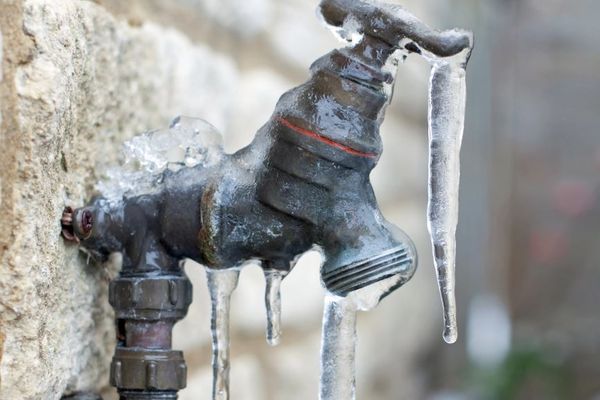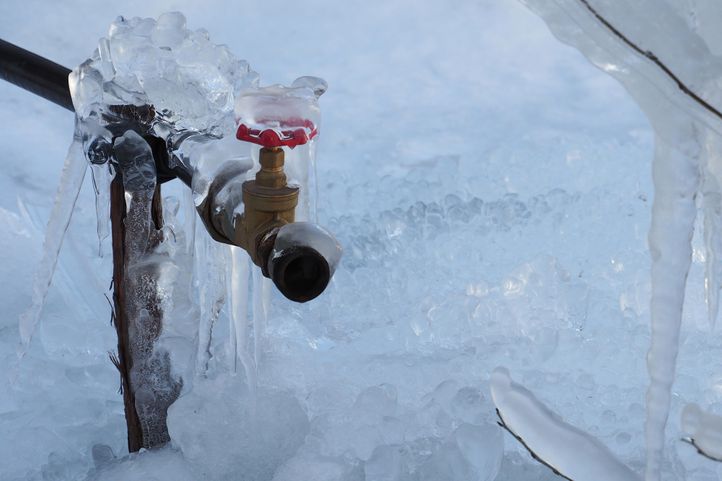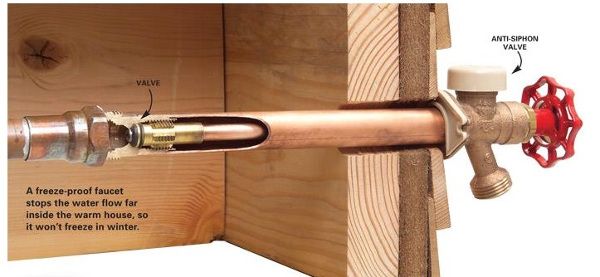Insulation is Key:
Ensure that pipes in vulnerable areas are adequately insulated. Use pipe sleeves, heat tape, or other insulation materials to protect against freezing temperatures.
Keep Your Home Warm:
Maintain a consistent indoor temperature, especially during extreme cold snaps. Set your thermostat to at least 55°F (13°C) when you're away to prevent temperature fluctuations that could lead to frozen pipes.
Seal Drafts and Gaps:
Identify and seal any drafts or gaps in your home's exterior, particularly around doors and windows. This helps maintain a warmer environment for your plumbing system.
Drip Faucets:
Allow a small amount of water to drip from faucets connected to vulnerable pipes. This continuous flow helps prevent freezing by relieving pressure within the pipes.
Dealing with a Plumbing Emergency:
Despite taking preventive measures, emergencies can still occur. If you discover frozen pipes or experience a plumbing disaster during a winter storm, here's what you can do:
Shut Off Water Supply:
Immediately turn off the main water supply to minimize damage. Knowing the location of your shut-off valve is crucial in emergencies.
Thaw Pipes Safely:
Use a hairdryer, heat lamp, or space heater to thaw frozen pipes gently. Never use an open flame or excessive heat, as it can damage pipes or pose a fire hazard.
Call a Professional: If you're unable to resolve the issue or if there's a burst pipe, contact a licensed plumber promptly. Professional help ensures proper repairs and minimizes further.
When water freezes, it expands in volume. This expansion can exert significant pressure on the walls of pipes, leading to pipe damage or bursts. The process of pipes freezing and bursting typically follows these steps:
Temperature Drop: When the ambient temperature drops below freezing, the water inside the pipes begins to lose heat to the surrounding environment.
Initial Ice Formation: As the temperature continues to decrease, the water inside the pipes starts to freeze at the point closest to the exposed surfaces. The initial ice formation occurs in small patches.
Ice Blockage Formation: As more ice forms, it creates a blockage within the pipe. The ice expands and can cause a gradual buildup of pressure within the pipe.
Increased Pressure: The expansion of ice inside the pipe leads to an increase in pressure. Since water has nowhere to go due to the ice blockage, this pressure continues to build up.
Pipe Burst: Eventually, the pressure becomes too much for the pipe to withstand, and it bursts. The burst typically occurs at the weakest point in the pipe, which could be a joint, fitting, or a section of the pipe that is under increased stress.
Several factors can contribute to the likelihood of pipes freezing and bursting:
Temperature: The lower the temperature, the faster water freezes and the greater the expansion of ice.
Duration of Freezing Temperatures: Prolonged exposure to freezing temperatures increases the likelihood of pipes freezing.
Insulation: Poorly insulated pipes are more susceptible to freezing. Insulation helps slow down the transfer of heat from the water to the surrounding air.
Wind Chill: Wind can accelerate the process of freezing by removing any insulating layer of air around the pipes.
Location of Pipes: Pipes located in unheated or poorly insulated areas, such as attics, basements, crawl spaces, or exterior walls, are more prone to freezing.
To prevent pipes from freezing and bursting, homeowners can take measures such as insulating pipes, keeping the home adequately heated, and allowing faucets to drip during extremely cold weather to keep water flowing. Additionally, draining and shutting off water to outdoor faucets before winter can help prevent freezing.
Preparing for winter weather is essential for homeowners to ensure the safety and well-being of their property and occupants. Here are some steps you can take to get ready for winter:
Inspect and Maintain Heating Systems:
Schedule a professional inspection for your heating system. Ensure it's in good working condition before the cold weather arrives.
Replace filters regularly to maintain efficiency.
Consider installing a programmable thermostat to optimize heating and save energy.
Seal Windows and Doors:
Check for drafts around windows and doors. Seal any gaps with weatherstripping or caulking.
Consider using thermal curtains to help insulate windows.
Insulate Pipes:
Insulate exposed pipes to prevent freezing and bursting. This is especially important for those in colder climates.
Disconnect garden hoses and shut off exterior water valves.
Clean Gutters:
Remove leaves, debris, and any blockages from gutters to prevent ice dams and water damage.
Ensure downspouts direct water away from the foundation.
Check the Roof:
Inspect the roof for damaged or missing shingles. Repair any issues to prevent leaks.
Trim overhanging branches to avoid potential damage from heavy snow or ice.
Stock Up on Winter Supplies:
Have an emergency kit that includes essentials like flashlights, batteries, blankets, non-perishable food, and water.
Keep a supply of ice melt, sand, or salt for treating walkways and driveways.
Service Outdoor Equipment:
Service and winterize outdoor equipment, such as lawnmowers and trimmers, before storing them for the season.
Test Smoke and Carbon Monoxide Detectors:
Ensure that smoke detectors and carbon monoxide detectors are working correctly by testing them regularly.
Prepare for Power Outages:
Consider investing in a generator for backup power during outages.
Keep a supply of candles, matches, and a battery-powered flashlight on hand.
Winterize Outdoor Spaces:
Store or cover outdoor furniture to protect it from the elements.
Drain and shut off sprinkler systems to prevent freezing.
Create a Snow Removal Plan:
Have snow shovels, a snow blower, or a snow removal service in place for clearing driveways and walkways.



